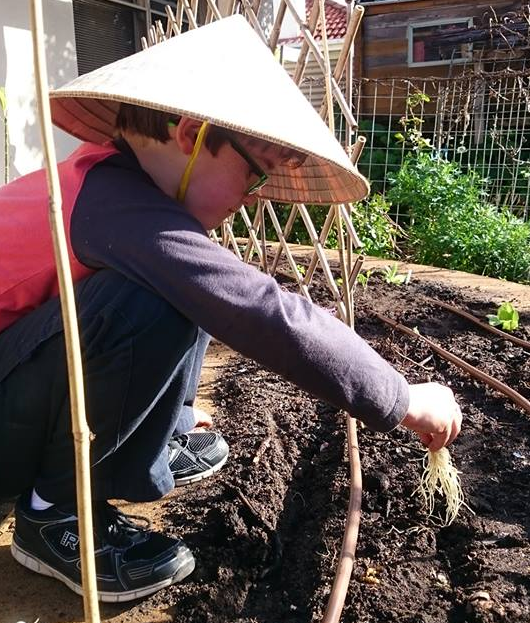
Spring onion bottoms get a second life, planted in a new Asian veg patch.
Reflections… It’s been a week spent between home in the ‘burbs and visiting the hills… remembering my teens when the frost and fog of the Adelaide Hills were an essential part of winter, missing the lush landscape and wildlife, while simultaneously feeling relieved and grateful as a gardener to have flat ground, fewer pests and weeds and a much warmer winter down here on the plains. Funny how much difference a half-hour drive makes to our local climate.
The local Mediterranean (dry temperate) climate and plants to suit it was also the subject of my presentation last week at Marion Cultural Centre – if you missed it, here are the slides, and you are welcome to email me for the notes (nadjasgarden@gmail.com).
So. Time to start seriously thinking about summer. Yes, it’s winter. Some rain going on here at last, but generally a pretty dry winter for Adelaide so far. Let’s get deciduous fruit trees and all local native plants into the ground this month so they have a chance to stretch their roots before they are faced with spring winds and summer scorchers. Not the evergreens though – hold your citrus, passionfruit and avocados until the soil warms up, but while you’re waiting get it really well built up with compost and old manure, and then have your irrigation supplies and mulch ready to roll when the bare bum test confirms that the soil is indeed comfortable enough for those subtropical babies.
In the photo at the top is one of our raised veg beds that has just had a thoroughgoing renovation. We have been paying the price for leaving gaps between the masonry blocks when the beds were built – water has been leaking through the sides and taking with it the finer soil particles and added nutrients, often leaving the beds dry and depleted. This bed has now been lined along each of its sides with sturdy plastic; the soil has been replenished with manure and home-made compost; and we’ve sown seeds for winter salad greens and snowpeas. Mustard greens especially – to deter root-knot nematodes before I plant tomatoes here for summer. I’m relieved to have this heavy job out of the way in the cooler weather, and to have had good steady rain to get the seeds on their way.
There are beautiful blooms everywhere. Native gardens are bursting with contrast as golden wattles and purple hardenbergia do battle for attention, while good old almonds, daisies and rosemary have the pastel shades covered and are keeping the bees busy. Many of the perennials have put on huge growth, which gives me an excuse to cut bunches of them for home and the market while I’m pruning. Rather than take off all the flowers at once, I like to trim different parts of the bushes every few weeks, so the bees don’t get too grumpy and the garden doesn’t lose all its colour.
In the coming month it will be time to start propagating (under cover) seedlings of those long-season summer crops, ready for planting out in spring. I’m talking particularly about tomatoes, basil, capsicum, chili and eggplant. These would all benefit from some bottom heat (a heat pad or a spot on top of a hot water service) to reach their desired temperature range for germination, and keeping them in a greenhouse or under a cold frame (e.g. an old window pane over a few poly boxes against a sunny wall) will get them through the rest of winter ready to hit the ground running in September-October. So start choosing seeds now (see market list below) and getting all your supplies in order: seed raising mix, punnets or trays, deep pots (or recycled milk cartons, yogurt tubs etc.) for transplanting into as they grow; labels (e.g. strips of plastic yogurt tubs marked with a soft lead pencil), poly boxes at the fruiterer, and keep an eye out for that discarded window in local hard rubbish piles.
What about all the other summer crops, you ask? Those with huge seeds like corn, zucchini, cucumber, melons and pumpkin can all wait to be planted directly into the ground when it is warm (late September onwards). Just work on a compost heap for now, because you’ll need it then. Starting them early in a greenhouse often backfires as the humidity predisposes them to mildew, and their extensive root systems don’t really like to be disturbed by transplanting – they’re better off sown direct. But if you really have to have corn and zucchini fritters before summer, at least start them off in deep containers like cut-off bottomless milk cartons standing in a box, so that you can plant the whole container in a big hole and then just slide it up and out leaving the plant and its rootball intact. Linda Woodrow has detailed instructions on this method in ‘The Permaculture Home Garden‘, one of my all-time favourite bedtime reads, and a classic for those winter days that are better suited to curling up with a notepad for garden planning than being out in the garden itself.
And in what remains of winter, let’s cram in a feast of cabbage, carrots, chives, coriander, dill, endive, fennel, spring onions, kale, lettuces, corn salad (mache), mizuna, mustard, onions, pak choi, parsley, parsnip, peas (including snowpeas), potatoes, radiccio, radish, rocket, silverbeet, swede, tatsoi and turnip.


Find us at Organic Corner Store market in Glenelg North Community Centre, corner of Kibby and Alison Ave, Glenelg North. Market is 9am-1pm EVERY Thursday (our stall is at market on the 1st and 3rd Thurs of each month).
